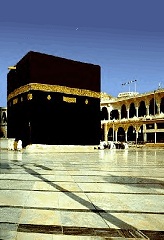
There is an unusual building in Mecca known as the Ka’abah. In Arabic this name means “cube” and it is a cube-shaped building of stone blocks. It is covered by a black cloth draped over it which is replaced annually. This is the place of pilgrimage for Muslims. Part of the pilgrimage is circling around the Ka’abah seven times.
According to Islamic tradition, the Ka’abah was built by Abraham and Ishmael. According to Islamic tradition this is the place, not Mount Moriah, where Abraham offered not Isaac, but Ishmael, before being stopped by Allah, not God. At the eastern corner of the Ka’abah is a black stone in a silver mounting. According to legend, the stone fell from Heaven and was brought to Abraham by an angel.

In his book Return to Mecca Avi Lipkin, a pro-Christian Israeli, has an interesting theory about the Ka’abah and the black, cubic phylacteries worn on arms and foreheads by orthodox Jews. The instruction for the phylacteries, which contain Scripture, began the day the Children of Israel left Egypt. (Exodus 13:9 & 16). More explicit instructions are found in Deuteronomy 6:8 and 11:18. Rabbi Lipkin believes that Moses was pointing the Children of Israel toward the black, cubic building in Mecca.
There is strong evidence that Mount Sinai, where the Lord met Moses while he tended the sheep of Jethro, was in Midian where Jethro lived in Arabia. Considering their numbers, an estimated two million people, scholars have questioned where the Israelites would have camped around the Mount Sinai in what is now called the Sinai Peninsula. They also wonder why the Israelites would remain in the Sinai Peninsula when Egypt had soldiers garrisoned in that area. But an answer to these questions is given by the Apostle Paul when he states that Mount Sinai is in Arabia. (Galatians 4:25)
In addition, Scripture says that Jethro was the priest of Midian. (Exodus 18:1) Avi Lipkin believes that Midian and Medina are names for the same place, and that Jethro was the priest of the Ka’abah in Mecca. In Hebrew the word for feast is chagag. Strong’s Exhaustive Concordance defines chagag (H2287) as “to move in a circle; to engage in a festival.” Gesenius’s Lexicon says the same word in Arabic means to go to Mecca in pilgrimage.
In Exodus 5:1 Aaron and Moses told Pharaoh, “Thus says the LORD God of Israel: ‘Let My people go, that they may hold a feast to Me in the wilderness.’” In this passage the word translated as “feast” is chagag. The opinion of Rabbi Lipkin is that Moses was telling Pharaoh, “Let us have a pilgrimage in the desert and move in circles.”
Rabbi Lipkin believes that Moses led the Children of Israel to Mount Sinai in Midian. He believes that the phylacteries were a reminder to show them their destination.
The theory of Rabbi Lipkin is that they wandered in the wilderness of Arabia. The Lord said, “Every place on which the sole of your foot treads shall be yours: from the wilderness and Lebanon, from the river, the River Euphrates, even to the Western (Mediterranean) Sea, shall be your territory.” (Deuteronomy 11:24) Lipkin says that throughout the deserts of Arabia are rocks with sandals and footprints inscribed on them. The Children of Israel were marking their territory.
Additional scriptural evidence of their location in the Arabian wilderness may be in the designation of “southward” in the instructions for the Tabernacle in Exodus 26:18. The Hebrew word for “southward” is teyman (Strong’s H8486). In modern Hebrew teyman is the word for Yemen. Yemen lies south of the Arabian Desert.
Rabbi Lipkin does not suggest that the Children of Israel were on an Arabic pilgrimage to Mecca, but rather that they have a claim to Mecca, to Medina, and to all the territory upon which the soles of their feet touched. He looks forward to the day when the people under the control of Islam will worship the One True and Living God. My prayer is also that the eyes of Avi Lipkin would be opened and he would see that Jesus is the Messiah, the Son of the One True and Living God. May the name of the Lord be praised forever!